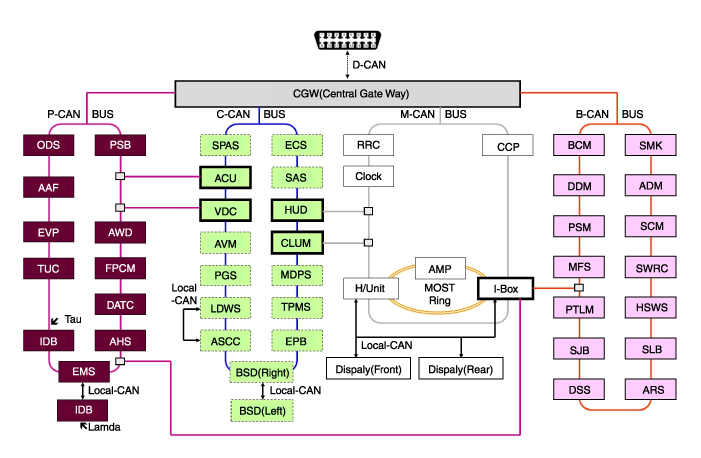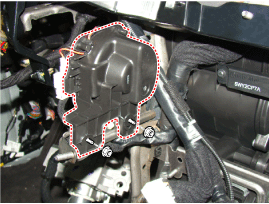Hyundai Genesis: Indicators And Gauges / Instrument Cluster Description and Operation
Hyundai Genesis (DH) 2013-2016 Service Manual / Body Electrical System / Indicators And Gauges / Instrument Cluster Description and Operation
| Description |
Communication Network Diagram

| Abbreviation | Explanation |
| AAF | Active Air Flap |
| ACU | Airbag Control Unit |
| ADM | Assist Door Module |
| AHD | Active Hood System |
| AMP | Amplifier |
| ARS | Armrest Switch |
| ASCC | Advanced Smart Cruise Control |
| AVM | Around View Monitor |
| AWD | All Wheel Drive |
| B_CAN | Body Controller Area Network |
| BCM | Body Control Module |
| BSD | Blind Spot Detection |
| C_CAN | Chassis Controller Area Network |
| CCP | Center Control Panel |
| CLUM | Cluster Module |
| DATC | Dual Automatic Temp Control |
| DDM | Driver Door Module |
| Display | Display Monitor |
| DSS | Driver Seat Switch |
| ECS | Electronic Control Suspention |
| EMS | Engine Management System |
| EPB | Electronic Parking Brake |
| EVP | Eva Vacuum Pump |
| FPCM | Fuel Pump Control Module |
| H/Unit | Head Unit |
| HSWS | Haptic Steering Warning System |
| HUD | Head Up Display |
| I-BOX | Telematics System |
| IDB | Integrated Dynamic Brake |
| LDWS | Lane Departure Warning System |
| M_CAN | Multi media Controller Area Network |
| MDPS | Motor Driven Power Steering |
| MFS | Multi-Function Switch |
| ODS | Occupant Detection System |
| P_CAN | Powertrain Controller Area Network |
| PGS | Parking Guide System |
| PSB | Pre-Safe Seat Belt |
| PSM | Power Seat Module |
| PTLM | Power Trunk Lid Module |
| RRC | Rear Remote Control |
| SAS | Steering Angle Sensor |
| SCM | Steering Column Module |
| SJB | Smart Junction Box |
| SLB | Seat Lumber Bolster |
| SMK | Smart Key Unit |
| SPAS | Smart Parking Assist System |
| SWRC | Steering Wheel Remote Controller |
| TCU | Transmission Control Unit |
| TPMS | Tire Pressure Monitoring System |
| VDC | Vehicle Dynamic Control |
Refer to the "Body Network System" for the abbreviation information. |
Cluster Variant Coding
As we have more options (ESC, TPMS, SCC, etc.) in the car,
the dashboard now have more information to display depending on the
chosen options.
For this reason, we need to learn which options the current vehicle when we replace the dashboard.
To address this issue, a course of learning based on the
option required for the vehicle when replacing the dashboard should be
carried out.
This is called Variant Coding.
Function
| 1. |
High speed CAN communication (C-CAN)
|
| 2. |
Low speed CAN communication (M-CAN)
|
| 3. |
Various source control
Various alarms and sound effects are issued through the external speakers connected to the instrument cluster.
|
| 4. |
User Setting Mode (USM)
Setting can be changed by using the haptic switch menu, and
CW, CCW, OK buttons (or the UP, Down, Left, Right and OK button of the
generic switch). There are total of 24 items (for example, In/Out Seat
Synchronization, In/Out Steering Wheel Synchronization, Auto Door Lock,
Auto Door Lock Deactivate, Head Lamp Escort, Welcome Light, Welcome
Sound, Triple Turn Signal, Average Fuel Consumption Auto Reset, HUD
Height Adjustment, Brightness, and Content Setup) that can be set and
customized. The signal flow during setting is as follows.
|
 Instrument Cluster Schematic Diagrams
Instrument Cluster Schematic Diagrams
Circuit Diagram
...
 Instrument Cluster Repair procedures
Instrument Cluster Repair procedures
Removal
Special care is needed for the following points in case of working with the non-gloss timber trimming.
•
Apply the protective tape to the tool when disassem ...
Other information:
Hyundai Genesis (DH) 2013-2016 Service Manual: Power Mosfet Repair procedures
Inspection 1. Turn the ignition switch ON. 2. Manually operate the control switch and control the voltage of the blower motor. 3. Select the control switch to raise the voltage until high speed. Specification Fan Speed (Manual)Motor Voltage (V)13.4 ± 0.5 (A/C OFF)3.8 ± 0.5 (A/C ON)24 ...
Hyundai Genesis (DH) 2013-2016 Service Manual: Steering Wheel Remote Controller (SWRC) Repair procedures
Inspection Steering Wheel Remote Control system (SWRC) can be diagnosed by GDS because it receives and sends signals through CAN communication. 1. Check for resistance between terminals in each switch position(LH). [Audio] SwitchConnectorterminalResistance(±5%)Speec ...
© 2013-2025 www.hgenesisdh.com


